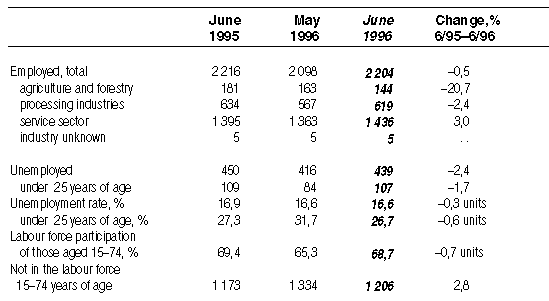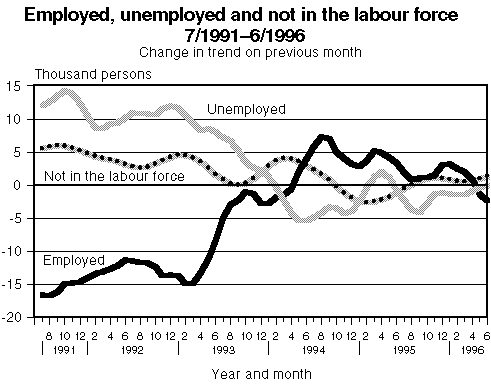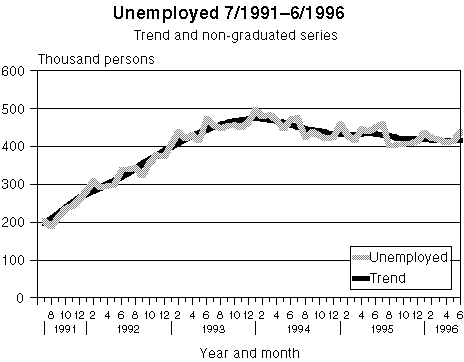25 July 1996
Employment improved in services, declined in primary production
The number of employed was down by ten thousand last month compared to June 1995, the Labour Force Survey of Statistics Finland indicates. The decline in total employment is largely accounted for by primary production, where there were almost 40 000 less jobs in June than the year before. In the service industries, instead, there was an improvement in employment. In trade and commerce, for example, the number of jobs increased by about 20 000.Women's employment fell while men's employment remained at last year's level. The highest number of jobs was recorded in the province of Uusimaa.
Seasonally adjusted figures show a fall in employment by a few thousand from May to June.
Unemployment stood at 439 000 in June, which is just over 10 000 less than the year before. The unemployment rate was down by 0.3 percentage points to 16.6 per cent. The unemployment rate of men was 15.8 per cent and that of women 17.5 per cent.
Changes in the labour force from June 1995 to June 1996, 1 000 persons

Unrounded figures are used in the CHANGE column figures.
The increase in unemployment from May to June is explained mainly by the seasonal variation caused by the entry of students on the job markets. Seasonally adjusted unemployment on the other hand remained at the same level as in May. There were 107 000 unemployed youths in June, i.e. roughly as many as the year before. The youth unemployment rate was down by 0.6 percentage points from June 1995 to 26.7 per cent. Of the entire age group of 633 000 youths, 17 per cent were unemployed.
In the government services 97 000 were left unemployed, while in manufacturing there were 54 000 unemployed, and in trade and commerce as well as construction the figure was 40 000.
Higher unemployment figures in the Ministry of Labour
The data for June's Labour Force Survey of Statistics Finland were collected by interviewing some 10 000 Finnish residents of working age. The Labour Force Survey is a panel survey where over a period of 18 months each person is included five times in the sample. The data released here cover the period of 10 - 16 June.The Labour Force Survey produces data both on employment and unemployment. It is based on the international recommendations of the International Labour Organisation (ILO) and the survey is comparable to statistics produced by other countries.
The Ministry of Labour also publishes statistics on unemployment. The data are on unemployed job seekers on the last working day of each month. Owing to differences in methods and definitions, the unemployment figures issued by Statistics Finland and the Ministry of Labour are not comparable. The trend in the changes is generally in the same direction, with the figures of the Ministry of Labour being higher by some thousands. At the end of June 459 200 unemployed persons were registered in the job applicants register of the Ministry of Labour.
When assessing the figures of the Labour Force Survey the confidence interval resulting from the standard error of the sample survey should also be taken into account. The interval was +-0.8 percentage points in the unemployment rate in June.


The changes in the unemployment figures are fairly regular in the different months of the year. This annual seasonal variation has been removed from the trends in the diagrams. The seasonal changes in the employment situation are more easily and quickly discerned from the trends than from non- graduated figures.
Source: Labour Force Survey, June 1996
Inquiries: Mr Tapio Oksanen, tel. +358 0 1734 3228, Mr Timo
Koskimäki,
tel. +358 0 1734 3517
